Of course, Chinese pen sellers don't call these pens by their Japanese name, but instead call them calligraphy or bent nib pens.
I had seen some very good reviews of Chinese bent nib pens, so I decided to try one.
I knew from past experience that if you order something from Chinese vendors via websites such as AliExpress or even Etsy, the shipping can be notoriously slow; your item may get stuck for up to two months in various places along the way before it ever leaves China.
But I decided to bite the bullet and order one and endure the long wait.
Duke 209
I settled on the Duke 209 which is often mentioned by artists on YouTube. This pen is slim and fits in the pocket nicely.

The bend in the nib is more curved than the Sailor which has a pretty abrupt bend.
Below is an on-the-spot sketch done with the Duke 209 fude nib pen.
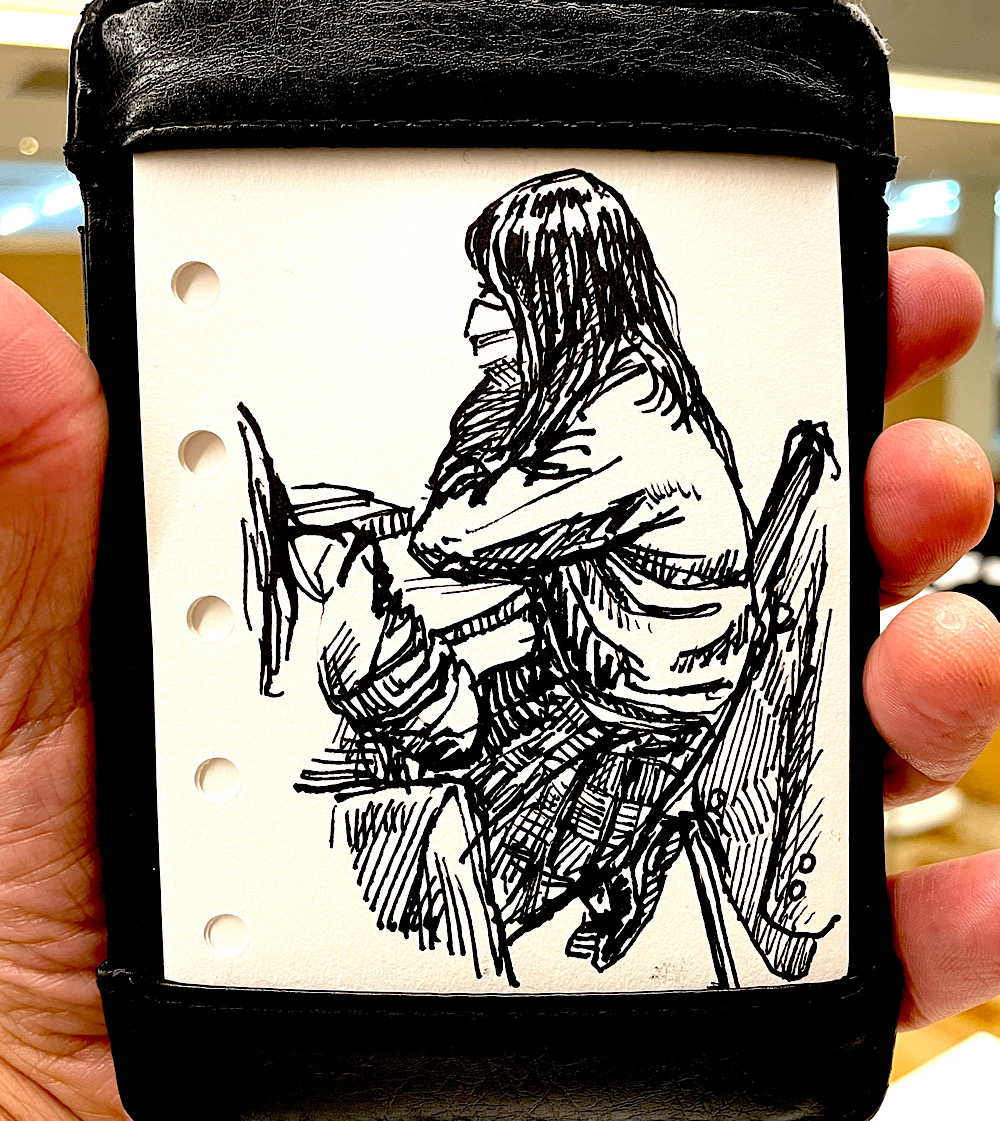
I love how I can get thick expressive lines and tight thin hatch lines with the same pen even on a very quick sketch where there is no time to think, let alone switch pens as you would have to do with Microns.
Duke 551
I also got the huge Duke 551 Confucius bent nib pen. This is a fairly well known fude nib pen which stands out from the rest.
It often appears in YouTube videos of Urban Sketchers in Asia and has become popular with artists around the world.
It's a big, heavy pen that can get very wide lines as well as fine lines.
It's a bit harder to handle than the Duke 209, but it's well balanced if you don't post the cap on the barrel.

If you are familiar with this model, then you will notice that the black finish is missing from the cap. I sanded it off and polished the underlying brass surface.
Below is a quick sketch I made with the Duke 551. It can get some very expressive lines.
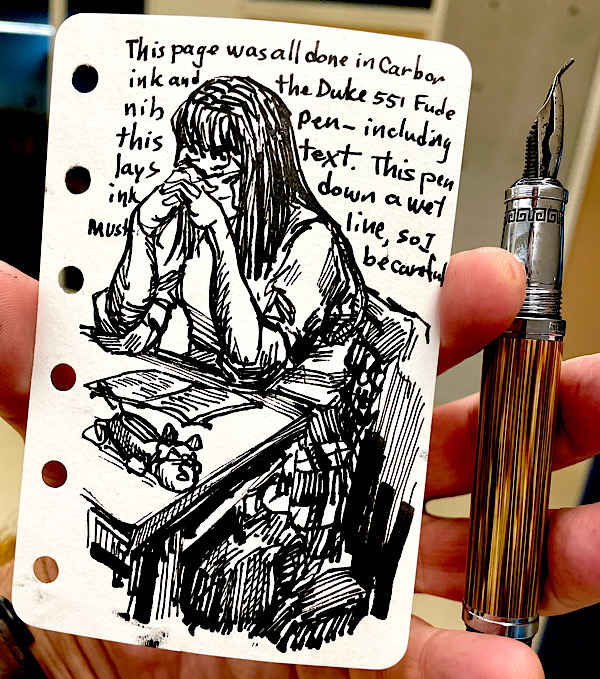
Below are two sketches rendered more carefully with the same pen. I didn't use the tip to its full potential because the strokes would have been too broad for my style at this size.
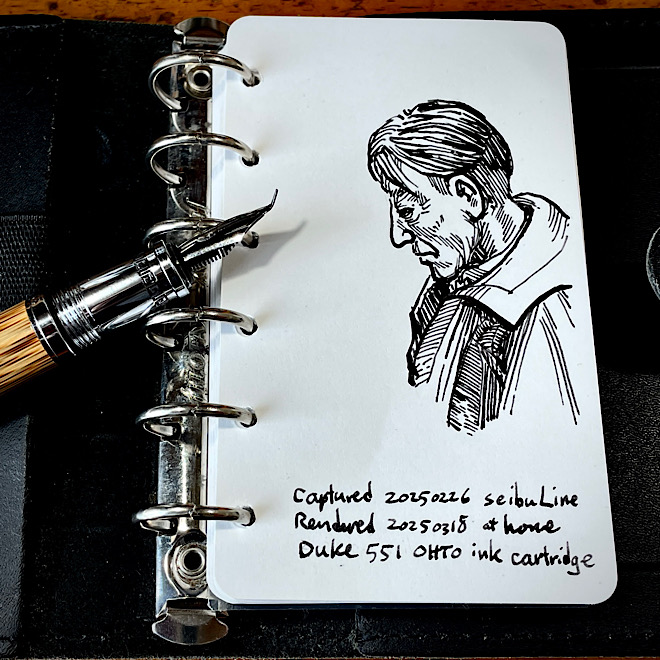
Of all my Chinese bent nib fountain pens, this one is in a class of its own because of it's huge size, the airtight screw-on cap and the shape of the tip which lets me get fine lines as well as the broadest lines you will ever want from a fountain pen.
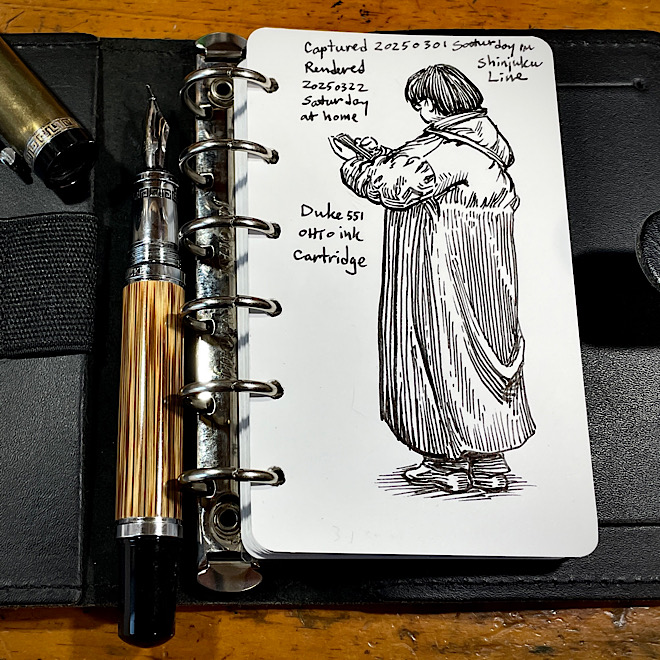
As wonderful as this pen is, I don't carry it around in my pocket because of the size and weight, but it's fun to use at home.


Duke Uranus 962
Several months later I ordered another Duke fountain pen. This was the Duke Uranus 962 with bent nib. What attracted me to this model is its size; it is very slim and light-weight.

This pen has a nib cover like the Duke 551 which possibly lets more ink get to the nib quicker, or maybe it keeps the ink wet longer.
Or it could just be for decoration since a nib cover makes more sense on a dip pen.
The nib is identical to the one on the Duke 209 except for the color (and the nib cover).
But the slim barrel makes it a smaller pen which is great to use and carry.
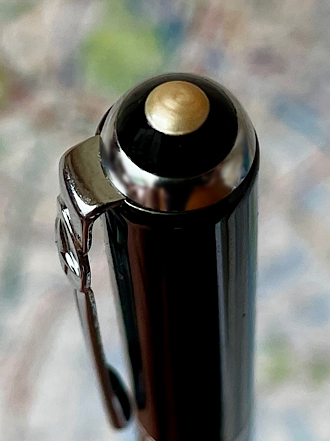 On the end of the cap there is a pearl-like jewel which might possibly represent the planet Uranus.
On the end of the cap there is a pearl-like jewel which might possibly represent the planet Uranus.
But you may want to refrain from saying, "I can see Uranus."
I loved this slim pen so much that I turned around and ordered another.
Jinhao X750
After a little more time browsing YouTube and the web, I bought two more bent nib pens. This time I chose the Jinhao X750. They were being sold on Amazon Japan as a pair, probably because they are so cheap at 940 yen each (around nine dollars at the time).

The main reason I chose this model was that several YouTubers said you could easily take these pens apart.
This makes them excellent "work horse" pens for drawing with carbon ink because I can take them apart and thoroughly clean them if the ink dries inside.
I later discovered that the Duke 209 and 962 Uranus pens also come apart easily. In the case of the Uranus pens, I first had to pull out the nib cover for the nib to come out.
The Jinhao X750 is bigger and heavier than the Duke 209 and Duke 962 Uranus pens, but not too heavy for sketching.
It's a wonderful choice for those who prefer full size pens, and its bent nib makes a great line just like my other Chinese bent nib pens.
Above is a quick sketch done with the Jinhao X750 bent nib pen.
Some differences between Chinese fude nib pens and the Japanese Fude DE Mannen
Here are some personal observations based on my experience with the pens mentioned above.

Curve of the nib
The bend in the Chinese nibs is more curved than the Japanese Fude DE Mannen, but I personally can't tell the difference when I'm using them.
Bend angle
All of my Chinese fude nib pens have nibs bent at a fairly high angle, somewhere between 45 and 55 degrees. That means you will have to hold the pen at a high angle to get a thin or even medium line because the nib angle naturally makes a broader line.
The Sailor comes in two versions, the lower 40 degree angle bend (shown in the photo) and a higher 55 degree angle bend. The 40 degree angle will get thin or medium lines when held at a natural angle, and broad lines when held at a lower angle.
Nib tips
Many Chinese fude nib pens have a ball of hard metal at the very tip (called tipping) to protect the nib from normal wear, and give a more smooth line.
The Sailor Fude DE Mannen has no tipping, but that allows it to get extra fine lines if you use the reverse side of the nib and move the pen sideways. That's a big deal if you want to do fine hatching.
One exception is the huge Duke 551 which I described above. That pen has no tipping and is probably the ultimate fude nib pen for line variation from extra fine to extremely broad.
These Chinese fude nib pens were amazingly inexpensive, but the quality control was also apparently low; I found a few scratchy nibs even with the tipping.
A little nib smoothing may be required, and you may need to do a web search to see how it's done. Don't ask me; I've nearly ruined more than a few nibs this way.
Air tight caps
The Chinese pens that have snap-on caps are not airtight, and the ink in the cartridge or converter can evaporate over a few weeks.
Of course, if you draw with the same pen frequently, then this won't be an issue.
The problem comes when you go nuts and buy a bunch of pens (like I did) and fill them all with ink and then let them sit in a pen cup for a long time.
It's better to keep one or two pens inked at a time and just use them until it's time to rotate pens.
The Fude DE Mannen pens and the Duke 551 have screw-on caps, and keep the ink wet even after weeks of storage.
Traveler's Company brass fude nib pen
Here is a secret which might be useful to some readers: I was able to swap the nib of my Duke 209 with the nib of my Traveler's Company brass fountain pen.
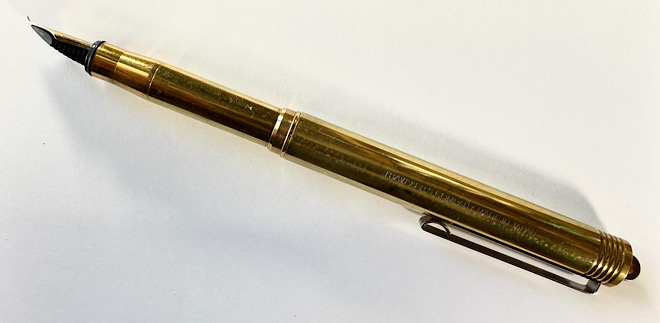
It was surprisingly easy, and both fit perfectly.
The result was a brass fountain pen with a fude nib that matches the color of the barrel.

By the way, if you like to polish the brass surface of the pen, do not polish the nib or it will probably turn silver as the gold colored plating comes off.
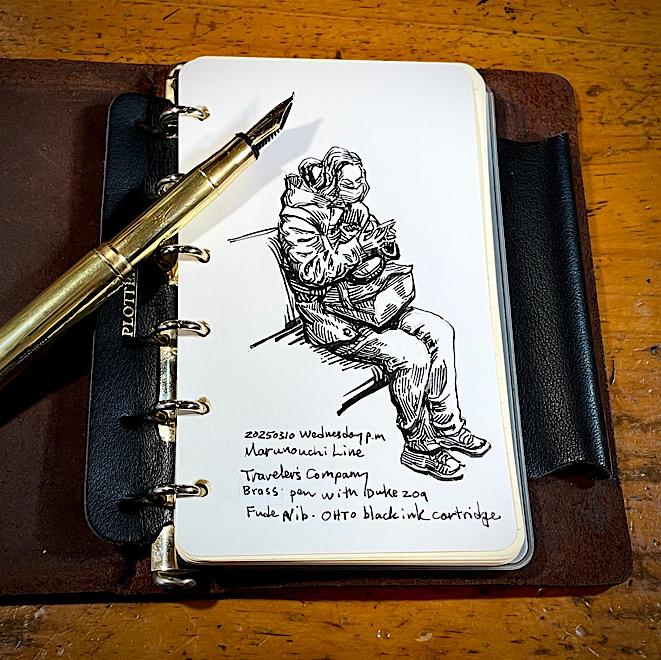
I'm sure the Duke Uranus 962 nibs will also fit the brass pen because they are identical to the Duke 209 nib except the silver color.
The Traveler's brass pen cap is snug and airtight, while the Duke 209 cap is apparently not, and the ink regularly dries up if I don't use it often.
Now I can use and store this nib in the brass pen with no problems.
Bent nibs, flex nibs and brush pens
Bent nib pens can magically turn your scribbles into interesting sketches, and the results are often unpredictable. There is more freedom to make expressive lines without thinking too much about it.
A flexible nib pen can only get thick lines on the down stroke which results in less line variation where you wanted it. If you are drawing at a desk, then this is not a problem since you can rotate the paper constantly, but sketching on location with a flex nib pen can be a real challenge.
A brush pen is capable of getting thick or thin lines in any direction, but it is hard to control especially if you are standing and holding a sketchbook. Again, if you are drawing at a desk, then this is not an issue.
A bent nib pen can get thick or thin lines in any direction and has a solid nib which can rest on the surface of paper as you draw. This gives you tactile feedback; you can feel what you are drawing and have greater control.
Bent nib pens can get a series of hatch strokes with a consistent uniform length and width, as well as the width of the gap between the strokes. This is difficult to do with a flex pen or brush pen when you are out sketching and are holding the sketchbook in one hand.
If you haven't tried bent nib pens for sketching on the spot, you ought to give them a try; they may turn out to be your best ink sketching pen.
The illustration at the top of this page of the dragon and pen was rendered by AI (Microsoft Bing's Copilot) and modified by me.
AI might take over illustration jobs in the future, but it will never take away sketching as a gratifying hobby.
Note about Amazon links: If you click on a link and buy something at Amazon, a few pennies per dollar goes into my Amazon account, so instead of letting Amazon keep it all, you can pry a few pennies from their fingers make them share it with me. Any other vendor links I may put on this website are just for your convenience.